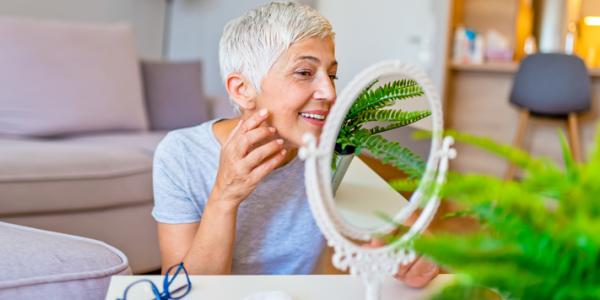
Acne can appear on different parts of your skin for different reasons. From hormones to genetics, discover what your skin breakouts might be telling you.
We often associate acne with teenagers, but it can impact everyone — from infants to full-grown adults, even after menopause. Acne can appear anywhere on our bodies, but especially on the face. But why might it be more prevalent on your forehead rather than your chin? Or on your cheeks rather than your forehead?
When new patches of pimples show up on our faces, understanding the cause is generally a priority. From diet to hormones, there are a lot of reasons as to where and how acne appears. Here's a breakdown of acne placement on the face and what it might be telling you:
- Forehead and nose: Commonly referred to as the "T-zone", this part of the face has more oil glands than other areas, which can cause more whiteheads, blackheads, or acne patches to appear. If you have pimples showing up by the hairline, consider changing the type of shampoo or conditioner you use. This could also mean that some of the products you use are causing buildup. There are several over-the-counter topical options that can help treat this particular area. Look for creams or ointments that contain salicylic acid, benzoyl peroxide or retinoids.
- Chin and jaw: Your chin and jaw area is more impacted by hormones than other areas of the face. Unlike acne from your T-zone, patches here are likely deeper and more inflamed. Speak with your doctor to go over treatment options, including retinoids and sulfur. For prolonged or more severe cases, birth control may be prescribed to help balance hormones.
- Cheeks: Unlike the T-zone or chin and jaw, acne on the cheeks is often due to genetics or environment, rather than hormones. Daily habits, such as prolonged phone use can be contributing factors. Consider using earbuds for calls in order to limit the amount of time a phone touches your face. Wearing masks without washing them consistently can also lead to breakouts, so make sure to throw reusable masks in the wash after each use. Avoid touching your face more than you need to, because the oils and bacteria from your hands can also irritate the skin. When it comes to treatment for acne on the cheeks, be cautious. Because the skin on your cheeks is more likely to dry out, limit how often you use acne creams, ointments or other treatments. Instead of using a daily cream, apply it every other day or talk to a doctor about a regimen that’s right for you.
Once you figure out why acne is showing up in a particular region, don't count on a one-size-fits-all solution. If you experience chronic problems and over-the-counter treatments don't seem to work, turn to a dermatologist or your primary care doctor for additional help.
Develop a healthy skincare routine, not only for your face, but for your entire body. Moisturize well and remember that what you put inside your body can certainly affect your skin. Some general and helpful skincare tips include:
- Eating less sugar
- Using sunscreen every day
- Hydrate, hydrate, hydrate — drink plenty of water
- Not smoking
- Using gentle products
- Keeping stress levels low
Because everyone has a different skin type, one of the best approaches is to try skin care products in moderation. But if you encounter bad side effects, or continually struggle with acne even in your adult years, reach out to a trusted doctor to start a treatment plan.
This article first appeared in the November 2021 edition of the HealthPerks newsletter.

